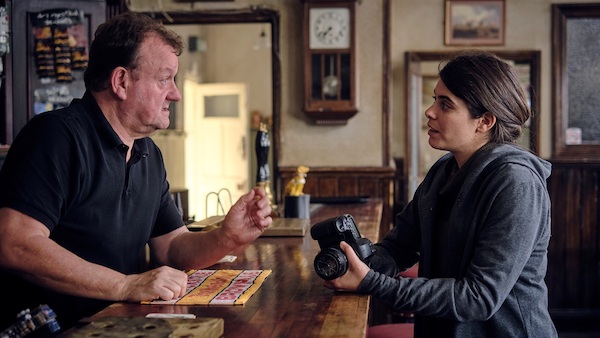Film Review: “The Old Oak” — Still Standing Tall
By Peter Keough
Veteran British director Ken Loach turns over a new leaf in The Old Oak.
The Old Oak. Directed by Ken Loach and written by Paul Laverty. At the Coolidge Corner Theatre.

Dave Turner and Ebla Mari in a scene from The Old Oak. Photo: Sixteen Films
“The camera saved my life,” says Yara (Ebla Mari), a young Syrian woman in Ken Loach’s The Old Oak. Uprooted by the violence in her homeland, she finds herself with her family in a depressed mining village in County Durham in northeast UK. “I saw a lot of things I wish I hadn’t seen,” she says of her time during the war. “I don’t have words to describe them. When I look through the camera I hope to see some hope and some strength.” An admirable if limited ideal, certainly more cogent than the ghoulish narcissism of the so-called photojournalists in Alex Garland’s Civil War, whose lust for images of carnage, suffering, and cruelty is for their own self-aggrandizement and morbid amusement.
Yara’s explanation of her art might well be the 87-year-old Loach’s statement about the purpose of this film, which he say is his last. And after a five-decade career of chronicling misery, injustice, and often futile resistance, of lionizing the working class in their endless struggle against the entitled and greedy, in films ranging from Poor Cow (1967) to Sorry We Missed You (2019), and including such masterworks of agit-prop miserabilism as Kes (1969), Ladybird Ladybird (1994), and My Name Is Joe (1998) — with the occasional lighter-hearted comedy such as 2013’s The Angels’ Share — who better deserves a break? That this film is not one of his best is perhaps beside the point — the fact that he can confront the deepening shithole of world affairs for so long and so honestly and still turn out such an optimistic outlook on human nature — that alone is inspiring.
Yara’s camera is the first casualty in the inevitable clash of cultures that the influx of desperate foreigners sparks in what turns out to be an angry, impotent community. A drunken yahoo breaks the device, leaving Yara angry and desolate (the camera had been a gift from her father, now lost somewhere in Assad’s prison system). TJ Ballantyne (Dave Turner), the proprietor of the pub of the film’s title, offers to help her restore it.
He takes her into the backroom of the bar, long unused and unmaintained because of lack of patronage, funds, and motivation, where his own father’s photographs of past miners’ strikes decorate the walls (these images and those of the Durham Miners Gala at the end of the film are reminiscent of Bill Morrison’s 2010 documentary The Miners’ Hymns). She admires the photos as he unearths the old man’s cameras. He tells her that he will trade them in to a camera store in exchange for repairs to her broken one.
Already the camera and images prove a bond between the two cultures. Later, Yara will take pictures of other residents and present them in a slideshow, mollifying the hate and mistrust of some — but not all. For the backroom becomes a disputed space. A handful of the Old Oak regulars ask TJ to open the room up so they can hold a meeting where townspeople can air their grievances about the new residents. TJ declines, insisting it would take too much work to set it up. In truth, it is more likely he wants to avoid the kind of orgy of hate, malice, and ignorance that roils the last part of Christian Mungiu’s R.M.N. (2023), a film about a similar situation but much darker, more pessimistic, and more unconventional in treatment.

Filmmaker Ken Loach in a 2016 interview — “Those in power try to distort reality, to suit their needs and keep things safe.”
Later, Yara and TJ’s activist friend Laura (Claire Rodgerson) suggests they instead rehab the space to serve free meals to the needy of the community, newcomers and natives alike. TJ is enthusiastic about the idea — when his father was organizing the doomed miners’ strikes back in the ’80s, communal meals kept their spirits up. In his mother’s words, “If you eat together, you stay together.” That is a bit lacking as a rallying cry perhaps, but most of the townspeople pitch in, churches and local unions donate food and the like. And, for a while it seems a success. Until, as expected, disaster strikes.
So TJ ends up on the beach, pondering perhaps taking a final swim out beyond the horizon, out to where his father died in an offshore mining disaster. It’s his It’s a Wonderful Life bridge moment. Earlier, he described how a few years before when his life was falling apart, with his marriage crumbling, his son estranged, and the pub failing, he had gone out to the beach on a similar errand. In lieu of an angel, a tiny dog came to his rescue. This time it’s not a dog but an angel of sorts, the angel of death, and a reminder that when grief and loss don’t bring out the worst in people, they can bring out the best.
Peter Keough writes about film and other topics and has contributed to numerous publications. He had been the film editor of the Boston Phoenix from 1989 to its demise in 2013 and has edited three books on film, most recently For Kids of All Ages: The National Society of Film Critics on Children’s Movies (Rowman & Littlefield, 2019).

